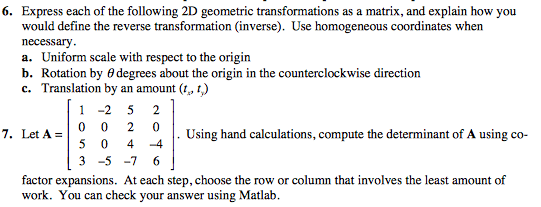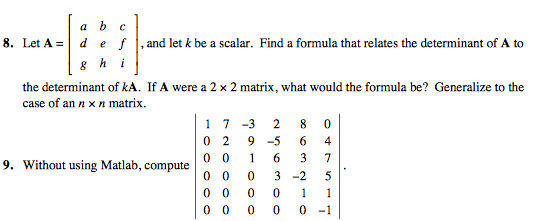MATH136 Lecture Notes - Lecture 28: Diagonal Matrix, Laplace Expansion, If And Only If

Wednesday, July 5
−
Lecture 28 : Determinants (Refers to 5.3)
Concepts:
1. Define the (i, j)-minor of a square matrix.
2. Define the (i, j)-cofactor of a square matrix.
3. Calculate the determinant of a square matrix by row or column expansion.
4. Apply the fact that the determinant of a triangular matrix is the product of the
entries on the diagonal.
5. Recognize that a triangular matrix A is invertible iff its determinant is not 0.
28.1 Determinants − Let M denote the set of all square matrices. A “determinant” can be
viewed as a function D : M → ℝ which maps any n × n matrix A to a real number
according to well defined formula applied to the entries of the matrix. Its general formula
will be stated explicitly below. We denote the determinant function by
D(A) = det(A) or | A |.
If A = [a11]1
× 1 then det(A) = a11. In the case of a 2 × 2 matrix A = [aij]2
× 2, the function
“det” is defined as:
det(A) = a11a22 − a12a21.
28.2 Definition − Let A = [aij] be an n × n matrix. For each entry aij in A, we associate a
matrix Mij of dimension n − 1 by n − 1 whose entries are the ones that remain when we
remove from A the row and the column containing the entry aij. We will refer to Mij as a
minor matrix of A associated to aij. We will call the number
mij = det(Mij) = | Mij |
the minor of the element aij, or the (i, j) minor.
Remark − Note that Mij is a matrix while mij is a real number. Also note that we have not
yet defined what det(Mij).
Second Remark − For an n × n matrix A there are n2 minors mij, one for each entry of A.
28.3 Definition − For each minor mij of an n × n matrix A, we define the (i, j)-cofactor cij as
cij = (−1)i + j mij.
28.3.1 Example. Let A be the matrix

Then (2, 3)-minor matrix, M23, is
Then m23 = det(M23) = 3 – 0 = 3 and c23 = (–1)2 + 3m23 = –3.
28.4 Definition − For an n × n matrix A = [aij]n × n . Suppose the det(Bm × m) is defined for
any positive integer m < n. Then all (i, j)-cofactors of A are all well-defined numbers.
We define the determinant of A, det(A) = | A | as :
Remark – Let M denote the set of all square matrices and Mn × n denote the set of all
n × n matrices for some n. According to this definition we see that the determinant
function D : M → ℝ is a “recursively defined function” on the set of matrices. This
means that we cannot determine the values of the determinants D : Mn × n → ℝ unless
we know the values of the determinants in D : Mm
× m → ℝ for m < n since
cij = (–1)i + j det(Mij).
It can be proven that such recursively defined functions are well-defined functions on the
set of all square matrices M. Having acknowledged this, we will henceforth accept this
as a proven fact.
Remark – We will soon see that there are many (often more convenient) ways of
computing the value of a determinant det(A).
28.4.1 Example – Let A be the matrix
We begin the “cofactor expansion along row 1” allowing us to find det A:
We compute det M14:

34
MATH136 Full Course Notes
Verified Note
34 documents
Document Summary
Wednesday, july 5 lecture 28 : determinants (refers to 5. 3) 28. 1 determinants let m denote the set of all square matrices. A determinant can be viewed as a function d : m which maps any n n matrix a to a real number according to well defined formula applied to the entries of the matrix. Its general formula will be stated explicitly below. In the case of a 2 2 matrix a = [aij]2 2, the function. Det is defined as: det(a) = a11a22 a12a21. 28. 2 definition let a = [aij] be an n n matrix. We will refer to mij as a minor matrix of a associated to aij. We will call the number the minor of the element aij, or the (i, j) minor. mij = det(mij) = | mij | Remark note that mij is a matrix while mij is a real number. Also note that we have not yet defined what det(mij).





